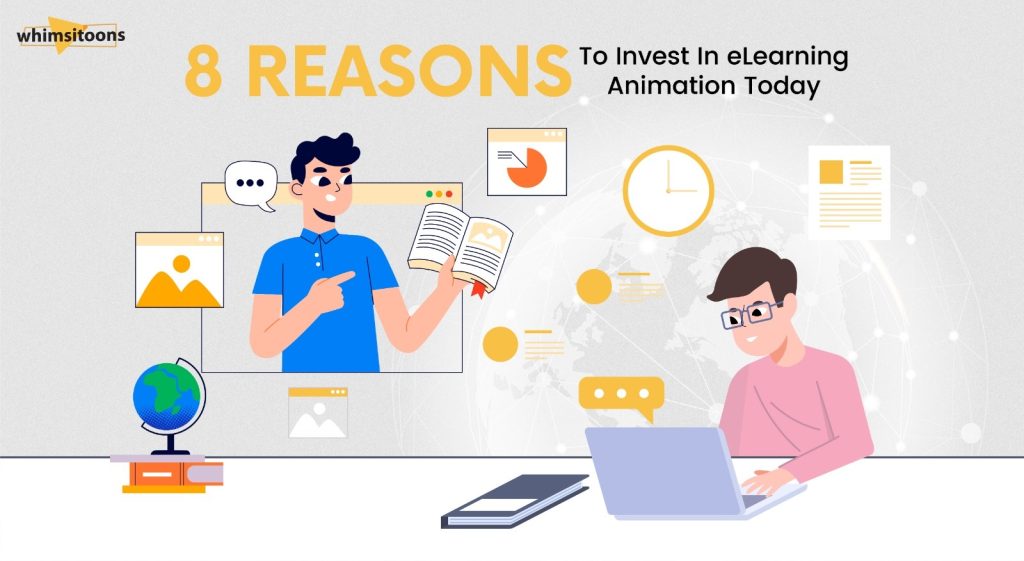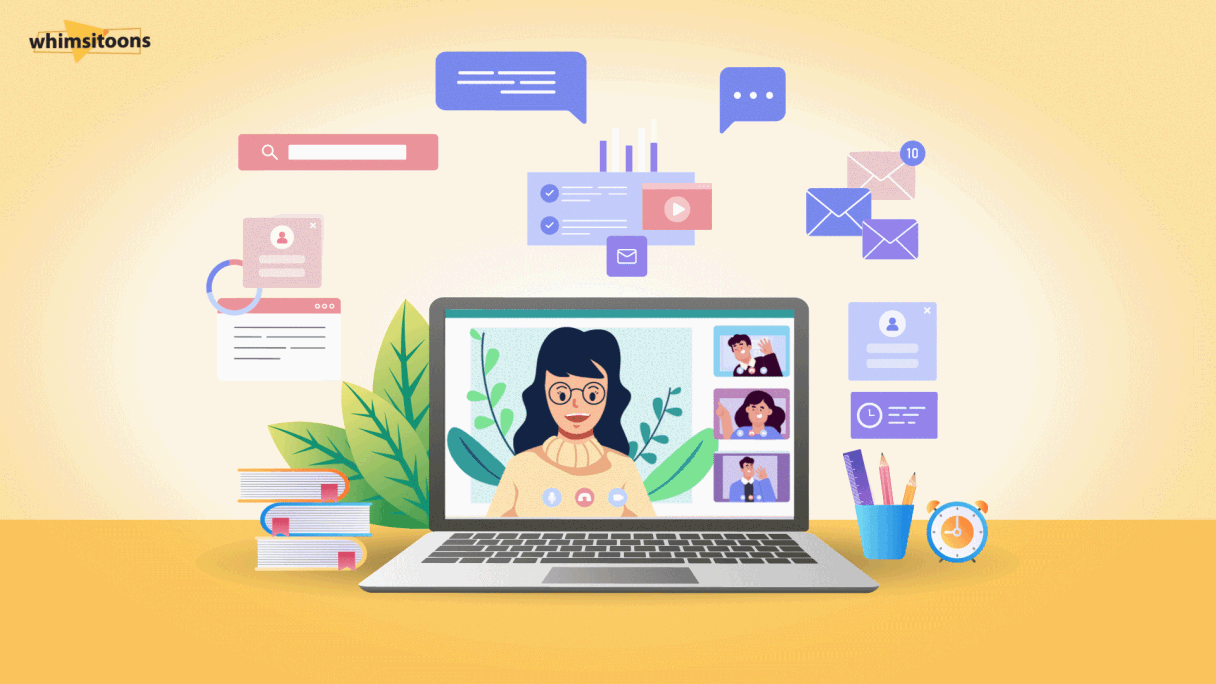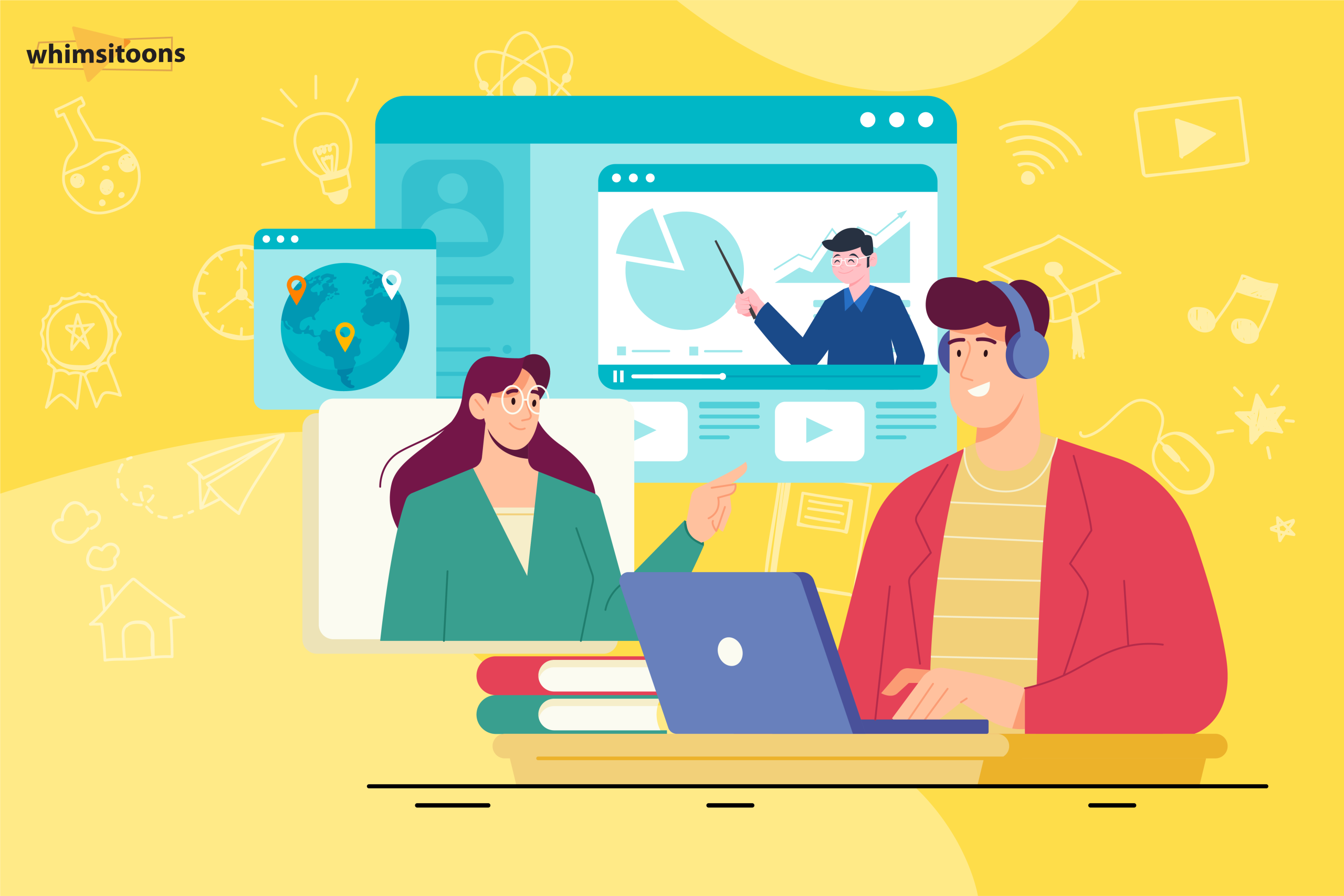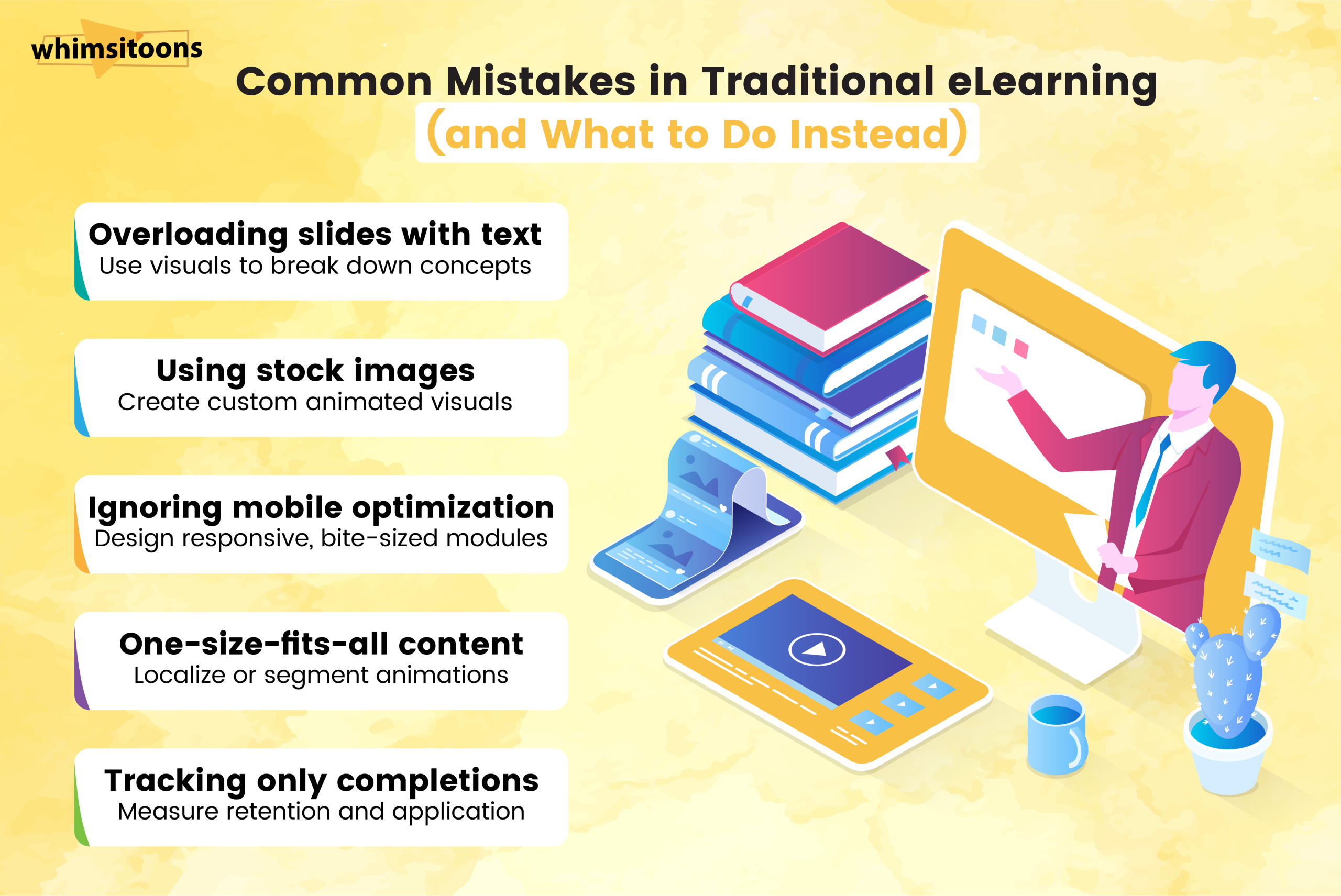8 Reasons To Invest In eLearning Animation Today

Finishing a course is easy; learning from it is not.
That’s the gap most training strategies overlook.
Just because someone completes a particular course doesn’t mean they’ve absorbed the content as well!
Static content often fades into the background, something learners click through rather than truly engage with or remember.
This is where e-learning animation makes a measurable difference by combining visual storytelling with instructional design, which helps learners absorb and remember the content.
That’s why more companies are starting to rethink their training methods.
With more than 80% of companies providing online learning or training, it’s evident that eLearning animations and interactive solutions are becoming more popular.
In this blog, we’ll break down why animation works and how it can dramatically improve learning outcomes across your training programs.
Key Takeaways:
|
What is eLearning Animation?

E-learning animation refers to using animated visuals to effectively deliver training content within a digital learning setting.
It may include motion graphics, character animation, explainer videos, and interactive video elements designed to teach, guide, or support learning.
Instead of relying on static slides or traditional talking-head videos, animated educational videos offer an interesting way to convey complicated subjects, engage viewers, and improve information retention.
Note:
|
A meta-analysis published in Educational Psychology Review reveals that instructional animations provide an important edge over static graphics, particularly for technical content. This enhancement leads to improved learning outcomes and understanding. |
Why Animation Is Essential in Modern eLearning

Today’s training isn’t just about teaching; it’s also about doing it quickly, easily, and in a way that works for all kinds of learners.
This is where e learning animation becomes essential, not optional.
1. Bridges the Skill Gap Faster
Teams in fast-moving industries like tech, finance, and healthcare must quickly adapt to new systems and regulations, especially when teams are distributed, systems change quickly, and job roles require immediate performance.
By showing key processes and tools, e-learning animation speeds up learning.
Real World Insight:
|
A case study conducted by Deloitte in the manufacturing industry revealed that the usage of virtual and interactive training methods, such as real-world settings, led to a 50–60% decrease in training time. |
2. Supports Diverse Learning Styles
Animation is equally beneficial to visual learners, auditory learners, and those who have trouble with text-based formats.
Animation blends sound, images, and timing, which makes it more efficient and inclusive than static content.
3. Boosts Consistency in Global Training
It’s hard for companies that do business in more than one region to make sure that their messages are consistent.
With e-learning video production, the same animated content can be translated, localized, and sent out all over the world.
This makes sure that it is always delivered the same way, without the need for live instructors.
4. Aligns with Just-in-Time Learning
Microlearning and performance support are becoming increasingly common in workplace learning.
Short e-learning animation courses improve memory and implementation by acting as on-demand training resources that students can review at any time.
What Makes eLearning Animation Effective (Science + Psychology)
Effective training goes beyond just sharing information; it’s more about presenting it in a way that aligns with how people learn.
Key Learning Theories Behind Animation:
Dual Coding Theory: People tend to remember information more effectively when it’s shown in both words and visuals.
Cognitive Load Theory: By simplifying difficult information into easily understood images, animation helps lessen the overload on the brain.
Multimedia Learning Principles: Richard Mayer proposed these principles, which highlight the combined effect of visuals and storytelling to improve understanding.
The 8 Reasons to Invest in eLearning Animation
Reason #1: Higher Learner Engagement and Completion Rates
E-learning animation simplifies content understanding, and with employees retaining 95% of video material (compared to just 10% from text), it stands out as a more effective way to train.
Reason #2: Explains Complex Concepts Clearly and Quickly
Animation for eLearning makes hard subjects easier to understand by breaking them down into simple, easy-to-follow steps.
This is especially helpful for students who have trouble with complicated concepts or have language barriers.
Reason #3: Scales Easily Across Teams, Departments, and Locations
eLearning courses video animation are a flexible solution for businesses with teams that work in different places.
Animated training can be used across departments or regions once it’s been made, so there’s no need for live sessions, printed materials, or repeated guidance.
It makes sure that all students get the same clear message, even if they are in a different time zone or learning from home or in a hybrid setting.
Reason #4: Reduces Long-Term Training Costs
While eLearning video production may require an initial investment, the return is quick.
Even though making eLearning videos requires some initial investment, you can quickly see a return on investment since you can reuse and scale the content; there’s no need to keep doing live sessions over and over.
Reason #5: Aligns with Modern LMS and Mobile Learning Platforms
Modern students often multitask or learn remotely while using their phones, tablets, or desktop computers to access and consume content.
Tools such as Articulate, Adobe Captivate, or Moodle make it easy to incorporate animation into SCORM-compliant modules.
Whether it’s during onboarding or just-in-time learning, learners can absorb content at their own pace with the help of e-learning animation and responsive design.
Reason #6: Strengthens Brand Identity and Training Culture
You can easily embed animation into SCORM-compliant modules, and it works great with tools like Moodle, Adobe Captivate, or Articulate.
E-learning animation helps with responsive design, making it easy for learners to take in content at their speed, whether they’re going through onboarding or picking up information when they need it.
Reason #7: Improves Retention and Learner Satisfaction
When it comes to training, retention is what really shows how successful it is.
If students forget what they’ve learned just a week later, then the program hasn’t succeeded, no matter how fast they went through it.
Animation taps into different senses like sight, sound, and emotions to make it easier for learners to understand and remember information.
Real World Scenario:
|
A fintech company’s customer support team’s post-training assessment scores increased by 45% after they transitioned from static slide-based modules to animated walkthroughs. |
Reason #8: Keeps Content Fresh and Reusable Over Time
Policies change, features get updated, and systems get better as time goes on.
With eLearning 3D animation, you can easily tweak and refresh specific product visuals without having to redo the whole module, keeping your training updates smooth and budget-friendly.
For example:
|
With eLearning 3D animation, you can change or re-render individual parts or features of a product without having to start over with the whole video. |
Ideal Animation Formats for Different Training Scenarios
|
Training Scenario |
Recommended Animation Style |
Why It Works |
|
Software Walkthroughs |
Motion Graphics |
Simulates UI/UX interactions |
|
Compliance Training |
Whiteboard Animation |
Simplifies legal or procedural content |
|
Product Demonstrations |
3D Animation |
Visualizes components and mechanisms |
|
Customer Onboarding |
2D Character Animation |
Builds connection and clarity |
|
Sales Enablement |
Infographic Animation |
Communicates value propositions fast |
Why eLearning Animation Should Be Part of Your Training Strategy
Online learning animation has become a popular choice for organizations looking to meet the changing demands of their learners for more effective, scalable, and interesting training.
This approach not only streamlines intricate subjects and enhances memory retention but also lowers long-term expenses and guarantees consistency among teams.
Are you ready to create learning that works?
Let’s discuss the potential of custom animated training with our Whimsitoons team to assist your organization in achieving quantifiable outcomes.
Reach out to us today to talk about your objectives and discover a personalized solution for eLearning animation.
FAQ
- How long does eLearning animation take to develop?
Creating an eLearning animation takes approximately 3 to 6 weeks, depending on the project’s complexity, length, and revision cycles.
- Is eLearning animation suitable for technical or compliance content?
Yes, eLearning animation is very effective for technical and compliance training because it breaks down complex topics into clear, visual explanations that are easier to understand and remember.
- Can animated training modules be SCORM-compliant?
Absolutely.
Animated training modules can be exported in SCORM-compliant formats, guaranteeing full compatibility with the majority of modern Learning Management Systems (LMS).
- What are the benefits of using animation in online education?
Animation in online education keeps students interested, helps them remember what they learn, makes hard topics easier to understand, and supports different ways of learning through visual storytelling.
- How does animation improve online learning?
Animation makes online learning better by lowering cognitive load, keeping students interested, and showing information in a way that makes it easier to understand and remember.











